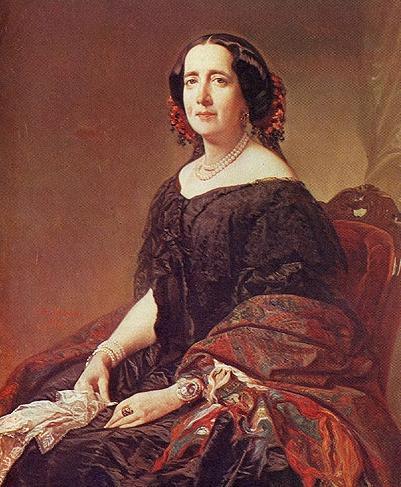2.1.8 The poetic work of Gertrudis Gómez de Avellaneda, the tenth muse (Puerto Príncipe, 1814 – Madrid, 1873)

Gertrudis Gómez de Avellaneda was one of the most transcendent voices in female lyric poetry of her time. With a distinctly romantic spirit, her contemporaries would honor her with the epithet “tenth muse” for the aesthetic quality of her work and the large number of works, not only poetic but also in the fields of theater and fiction, that were due to her talent.
In 1836, she emigrated to Spain, and this year, according to the consensus of many critics, marked the true dawn of her literary career. One of her most distinguished poems, perhaps truly Cuban in that the author had not yet set foot on Spanish soil, entitled “Al partir,” was composed precisely before her trip to Spain. The first stanza stands out for its direct allusion to Cuba:
“Pearl of the sea! Star of the West!
Beautiful Cuba! Your bright sky
The night covers with its opaque veil,
“How pain covers my sad forehead.”
He spent 23 years of his life on the Iberian Peninsula. It was there that he finally honed his poetic instrument, strongly influenced by Hispanic literature. He endured the social contradictions of the time, experienced firsthand the joys and tragedies of love, and captured all of this in his works in a masterful way. However, these works are no longer perceived in the same way today, and what were his most cherished values from a nineteenth-century aesthetic perspective are now diluted by similarities with the linguistic registers of other poets then considered lesser.
Her belonging to Cuban literature has been a frequent subject of controversy in the fields of literary criticism and historiography. The influence that literature and Hispanic society itself exerted on her is undeniable. In addition to remaining on the surface of Cuban culture—with non-internalized descriptions of nature, limited depth of social penetration, and virtually no political connotation—she nevertheless became somewhat entangled in the independence struggle upon her return to Cuba, with an ideological lag of decades. However, this does not mean that she should be dissociated from the process of national formation, precisely when this process had been struggling with identical contradictions regarding Cuban and Spanish values.
The poetess had a vital attitude and left behind a literary work that allows her to be described as a precursor of feminism in America, this stems from her own choice to live somewhat outside her family, unusual for a young woman, and the network of her love affairs, all of which determined a precarious position in society, linked on the one hand to the aristocracy and object of its malicious sympathy, but at the same time under perennial scrutiny, which did not prevent her from developing her personal lifestyle, but did cause her suffering, also derived from the Catholic faith that had been instilled in her from the cradle.
Cintio Vitier unravels some of the enthusiasm she sparked among her contemporaries: “We sense in her a passion, a fire, a burst of enthusiasm that no other Spanish poet has ever had, and that heralds the American female voices of our times. She is now, completely, the type of Hispanic-American woman (…) who eagerly throws herself into life and knowledge, who takes risks like a man in the pursuit of happiness and creative ambition, and who generally succumbs, consumed by her own flames.”
It is true that his work has become somewhat ossified from the perspective of the 20th-century aesthetic perspective, although not entirely; rather, a reversal has occurred, and many poems that were not highly regarded have been rightly revalued from a new perspective. This has been the case, however, and pieces that brought him great accolades no longer inspire such admiration today. However, his place in Latin American literature and his metrical and rhythmic brilliance, an aspect in which he played a truly innovative role, are not disputed.








